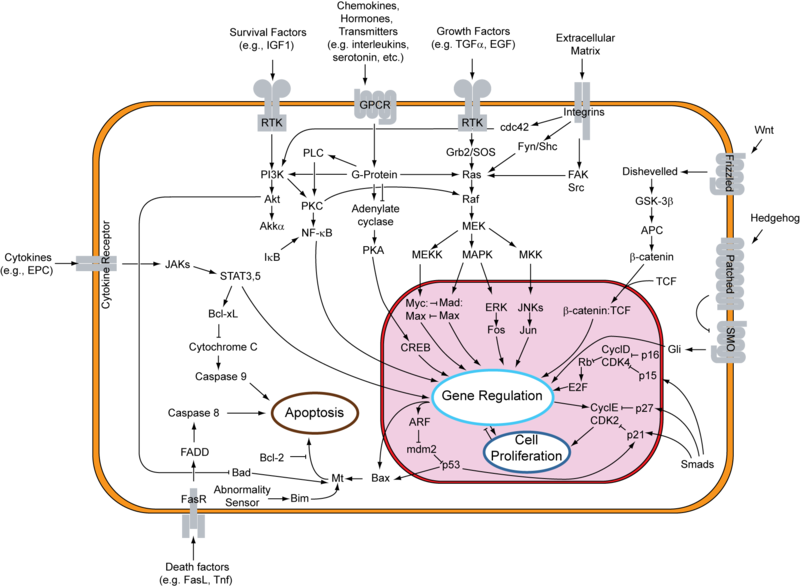Samer Kawak sandbox
From Proteopedia
Contents |
BAX Protein
About Structure
| |||||||||
| 1f16, 20 NMR models () | |||||||||
|---|---|---|---|---|---|---|---|---|---|
| |||||||||
| |||||||||
| Resources: | FirstGlance, OCA, RCSB, PDBsum | ||||||||
| Coordinates: | save as pdb, mmCIF, xml | ||||||||
Apoptosis is stimulated by the insertion of BAX from the cytosol into mitochondrial membranes. Suzuki et al. (2000) determined the solution structure of BAX, including the putative transmembrane domain at the C terminus, in order to understand the regulation of its subcellular location. BAX consists of 9 alpha helices, and the assembly of helices alpha-1 through -8 resembles that of BCLXL. The C-terminal alpha-9 helix occupies the hydrophobic pocket proposed to mediate heterodimer formation and bioactivity of opposing members of the BCL2 family. The authors concluded that the BAX structure shows that the orientation of helix alpha-9 provides simultaneous control over its mitochondrial targeting and dimer formation.
Gavathiotis et al. (2008) demonstrated by nuclear magnetic resonance (NMR) analysis that the BIM stabilized alpha-helix of BCL2 (SAHB) domain binds BAX at an interaction site that is distinct from the canonic binding groove characterized for antiapoptotic proteins. The specificity of the human BIM-SAHB-BAX interaction was highlighted by point mutagenesis that disrupts functional activity, confirming that BAX activation is initiated at this novel structural location. The BAX binding site is defined by lysine at (K21), glutamine at (Q28, Q32), arginine at (R134), and glutamic acid at (E131).
Overview of BAX and Apoptosis
By definition, apoptosis is programmed cell death, or suicide. To induce cell death among cancer cells is a critical component to cancer treatment. Specifically, the Bcl-2 protein family members have been found to have a prominent role in apoptosis, yet researchers have not been able to deduce more information on their mechanisms. Bcl-2 proteins occupy the mitochondrial outer membrane permeabilization, and are recognized either as pro-apoptotic (Bax, BAD, Bak, and Bok) or anti-apoptotic (Bcl-2 proper, Bcl-xL, and Bcl-w). Pro-apoptotic Bcl-2 proteins are death-promoting members while anti-apoptotic members are death-inhibiting structures. Currently, researchers have identified 25 genes in the Bcl-2 family.
One particular Bcl-2 protein is the Bax protein, one of the death-promoting members. To date, researchers have found great trouble deciphering the nature of the Bax protein in the cell. Past studies have overexpressed the Bax protein in in vitro and in vivo studies to discover more information on its function. However, some of the criticism from such methods is that these conditions are not indicative of the normal activity of Bax. Either way, there have been mixed results through these types of studies.
Zhang et al. (2000) Study
| |||||||||
| 1f16, 20 NMR models () | |||||||||
|---|---|---|---|---|---|---|---|---|---|
| |||||||||
| |||||||||
| Resources: | FirstGlance, OCA, RCSB, PDBsum | ||||||||
| Coordinates: | save as pdb, mmCIF, xml | ||||||||
In the 2000 study by Lin Zhang, Jian Yu, Ben Ho Park, Kenneth W. Kinzler, and Bert Vogelstein titled “Role of Bax in the Apoptotic Response to Anticancer Agents,” the experimenters evaluated the role of the Bax protein in drug-induced apoptosis in human colorectal cancer cells. The review described several experiments that all attempted to elucidate the mystery behind the Bax protein.
For the first experiment, the researchers used the fact that chemotherapeutic agents usually target epithelial cells to clarify the role of Bax in drug-induced apoptosis in epithelial cells through the creation and analysis of isogenic derivatives that vary only in the presence or absence of the Bax gene. The results from this experiment showed that 2% of HCT116 (or epithelial parental cells) have two intact Bax alleles (+/+), 94% had one intact allele (+/-), and 4% had two mutant alleles (-/-).
In another experiment, the experiments presented that hypothesis that if Bax deficiency greatly affects the sensitivity to non-steroidal anti-inflammatory drugs (NSAIDs), which were previously test in a different experiment, then the parental cell populations treated with NSAIDs result in a mutated Bax cell population. After recovering grown Bax cells from an in vitro study with the NSAID indomethacin. The results showed that 70% of the Bax cells had insertions or deletions in the G8 tracts of both Bax alleles while 4% had mutations in the parental population.
Ultimately, in regards to the clinical implications from this study, the results suggest that colorectal tumors may easily develop resistance to NSAIDs through an inherent instability in the mononucleotide tract (at nucleotides 114 to 121 or ) in BAX, but more importantly, a combination of chemopreventive drugs must be considered as a leading cancer treatment.
Reference
Gavathiotis E, Suzuki M, Davis ML, Pitter K, Bird GH, Katz SG, Tu HC, Kim H, Cheng EH, Tjandra N, Walensky LDBAX activation is initiated at a novel interaction siteNature v455, p.1076-1081
structure obtained by: BAX activation is initiated at a novel interaction site. Gavathiotis, E., Suzuki, M., Davis, M.L., Pitter, K., Bird, G.H., Katz, S.G., Tu, H.C., Kim, H., Cheng, E.H., Tjandra, N., Walensky, L.D.(2008) Nature 455: 1076-1081
- Kussie PH, Gorina S, Marechal V, Elenbaas B, Moreau J, Levine AJ, Pavletich NP. Structure of the MDM2 oncoprotein bound to the p53 tumor suppressor transactivation domain. Science. 1996 Nov 8;274(5289):948-53. PMID:8875929


